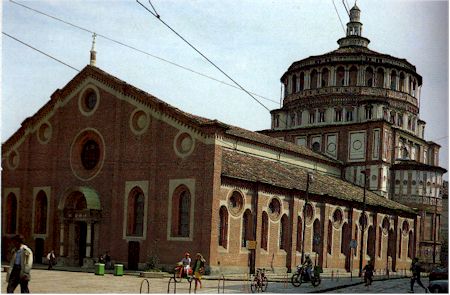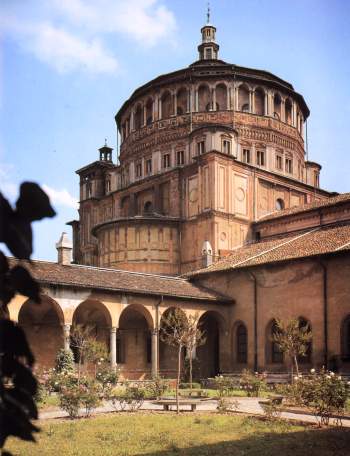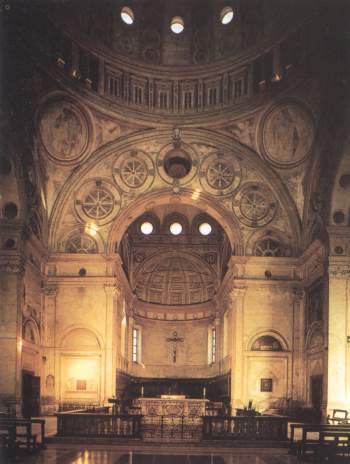
The unique blend of simple elegant Tuscan architectural forms and colourful Lombard
decorative motifs produced an extraordinary offspring: the church of Santa Maria delle
Grazie. In 1463, a captain in
Francesco Sforza's army,
Gaspare Vimercati,
donated a plot of land to the Dominican order. On the site was a chapel adorned with
a fresco of the Virgin, so called
Madonna delle Grazie. The monks commissioned
Guiniforte Solari to build a church and monastery on the plot, and ground was
broken on September 10, 1463. The church that Solari built between 1466 and 1490 is
a typical example of the transition stage between Gothic and Renaissance, as can be
seen in the Lombard style gabled fašade decorated with pilaster strips and pierced
by a single opening below and several niches above. Only the gabled portal belongs
to the period when the Renaissance architect
Donato Bramante was involved in

the work. The church was just about ready - the presbytery and apse had already been
finished - when the new ruler of Milan,
Ludovico il Moro, ordered it enlarged.
Both presbytery and apse were torn down so that Donato Bramante could put up his own
design for the huge apse. It was begun in March 1492 and when it was completed in
1497 Ludovico had his wife,
Beatrice d'Este, buried there.
Bramante's great
tribune was a lesson in Renaissance architecture to the artists of Lombardy, even
though his idea of three apses radiating from a square is actually based on an older
building (the Parma Cathedral). Nevertheless, we must not fail to mention that
the great Florentine architect of the Early Renaissance, Brunelleschi, greatly
influenced Bramante's concept of simple, perfectly proportioned, harmonious space.
From the outside the tribune looks like a giant wheel resting upon a cube. The decorative
effect is enhanced by the double column arcade encircling the top part of the dome and
the use of rectangular windows alternating with pilasters cut into the lower level.
Geometric patterns in brickwork make an attractive contrast against the neutral colour
of the wall surface. All of these elements combine to give a sense of spatial grandeur
satisfying both eye and spirit.
The interior, like the outside of the church, is richly
satisfying in its magnificently conceived contrast of the nave's Gothic purity and the

tribune's Renaissance decorativeness. Guiniforte Solari designed the nave with its Gothic
style pointed arches. The strong downward thrust of the arches brusquely interrupted
where the pilaster strips join the decorated capitals of the columns, create a feeling
of great spaciousness in the nave. The rhythmic procession of columns leads us to
Bramante's tribune. The inside of the cube with its strictly geometric partition of
space appears fragmented by the use of colourful decorative motifs. The four huge
arches, one for each side of the cube, join the lower spaced to the dome, by means
of pendentives. The end arch opens into the presbytery, whereas the other two-form
giant niches on either side of the choir. The painted decoration is extremely simple,
and it's in the extreme simplicity of the geometrical motifs, that the originality of
Bramante's conception lies. Only three designs, the circle, the square, and the spoked
wheel are used, and they are harmoniously repeated.

 The unique blend of simple elegant Tuscan architectural forms and colourful Lombard
decorative motifs produced an extraordinary offspring: the church of Santa Maria delle
Grazie. In 1463, a captain in Francesco Sforza's army, Gaspare Vimercati,
donated a plot of land to the Dominican order. On the site was a chapel adorned with
a fresco of the Virgin, so called Madonna delle Grazie. The monks commissioned
Guiniforte Solari to build a church and monastery on the plot, and ground was
broken on September 10, 1463. The church that Solari built between 1466 and 1490 is
a typical example of the transition stage between Gothic and Renaissance, as can be
seen in the Lombard style gabled fašade decorated with pilaster strips and pierced
by a single opening below and several niches above. Only the gabled portal belongs
to the period when the Renaissance architect Donato Bramante was involved in
The unique blend of simple elegant Tuscan architectural forms and colourful Lombard
decorative motifs produced an extraordinary offspring: the church of Santa Maria delle
Grazie. In 1463, a captain in Francesco Sforza's army, Gaspare Vimercati,
donated a plot of land to the Dominican order. On the site was a chapel adorned with
a fresco of the Virgin, so called Madonna delle Grazie. The monks commissioned
Guiniforte Solari to build a church and monastery on the plot, and ground was
broken on September 10, 1463. The church that Solari built between 1466 and 1490 is
a typical example of the transition stage between Gothic and Renaissance, as can be
seen in the Lombard style gabled fašade decorated with pilaster strips and pierced
by a single opening below and several niches above. Only the gabled portal belongs
to the period when the Renaissance architect Donato Bramante was involved in
 the work. The church was just about ready - the presbytery and apse had already been
finished - when the new ruler of Milan, Ludovico il Moro, ordered it enlarged.
Both presbytery and apse were torn down so that Donato Bramante could put up his own
design for the huge apse. It was begun in March 1492 and when it was completed in
1497 Ludovico had his wife, Beatrice d'Este, buried there.
the work. The church was just about ready - the presbytery and apse had already been
finished - when the new ruler of Milan, Ludovico il Moro, ordered it enlarged.
Both presbytery and apse were torn down so that Donato Bramante could put up his own
design for the huge apse. It was begun in March 1492 and when it was completed in
1497 Ludovico had his wife, Beatrice d'Este, buried there. tribune's Renaissance decorativeness. Guiniforte Solari designed the nave with its Gothic
style pointed arches. The strong downward thrust of the arches brusquely interrupted
where the pilaster strips join the decorated capitals of the columns, create a feeling
of great spaciousness in the nave. The rhythmic procession of columns leads us to
Bramante's tribune. The inside of the cube with its strictly geometric partition of
space appears fragmented by the use of colourful decorative motifs. The four huge
arches, one for each side of the cube, join the lower spaced to the dome, by means
of pendentives. The end arch opens into the presbytery, whereas the other two-form
giant niches on either side of the choir. The painted decoration is extremely simple,
and it's in the extreme simplicity of the geometrical motifs, that the originality of
Bramante's conception lies. Only three designs, the circle, the square, and the spoked
wheel are used, and they are harmoniously repeated.
tribune's Renaissance decorativeness. Guiniforte Solari designed the nave with its Gothic
style pointed arches. The strong downward thrust of the arches brusquely interrupted
where the pilaster strips join the decorated capitals of the columns, create a feeling
of great spaciousness in the nave. The rhythmic procession of columns leads us to
Bramante's tribune. The inside of the cube with its strictly geometric partition of
space appears fragmented by the use of colourful decorative motifs. The four huge
arches, one for each side of the cube, join the lower spaced to the dome, by means
of pendentives. The end arch opens into the presbytery, whereas the other two-form
giant niches on either side of the choir. The painted decoration is extremely simple,
and it's in the extreme simplicity of the geometrical motifs, that the originality of
Bramante's conception lies. Only three designs, the circle, the square, and the spoked
wheel are used, and they are harmoniously repeated.